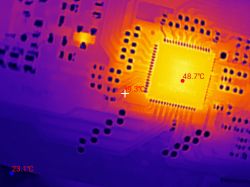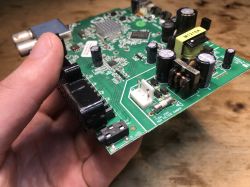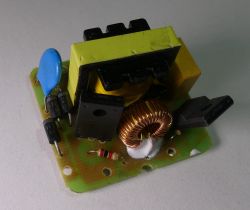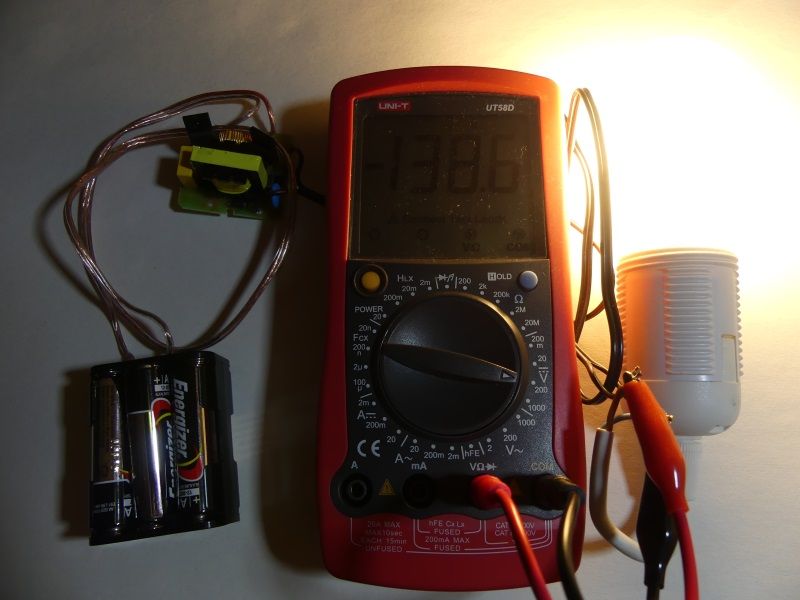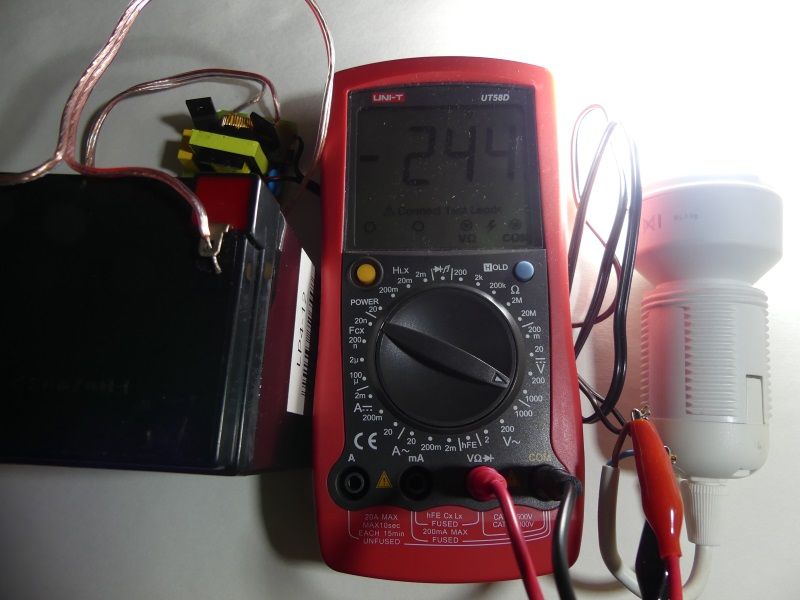The module you see in the picture can be found on auction sites as a 40W 12DC to 220VAC converter . Seeing the design of the device in the photo, I wasn't expecting much for the price of $ 2. I was hoping that the module would work and allow you to power a 230V GU10 compact fluorescent lamp or "bulbs".
After starting the module, as expected, it turned out that a ~ 40kHz sine wave appears on the secondary side of the transformer, the effective voltage may reach several hundred volts in no-load condition. As the power consumption increases, the output voltage drops to the 220V visible in the description and even less 90-100V. On the board you will find the fields marked -12V (GND) and + 12V where we connect the 8-12V supply voltage. In points B and D we get a rectified output voltage of 100-300V.
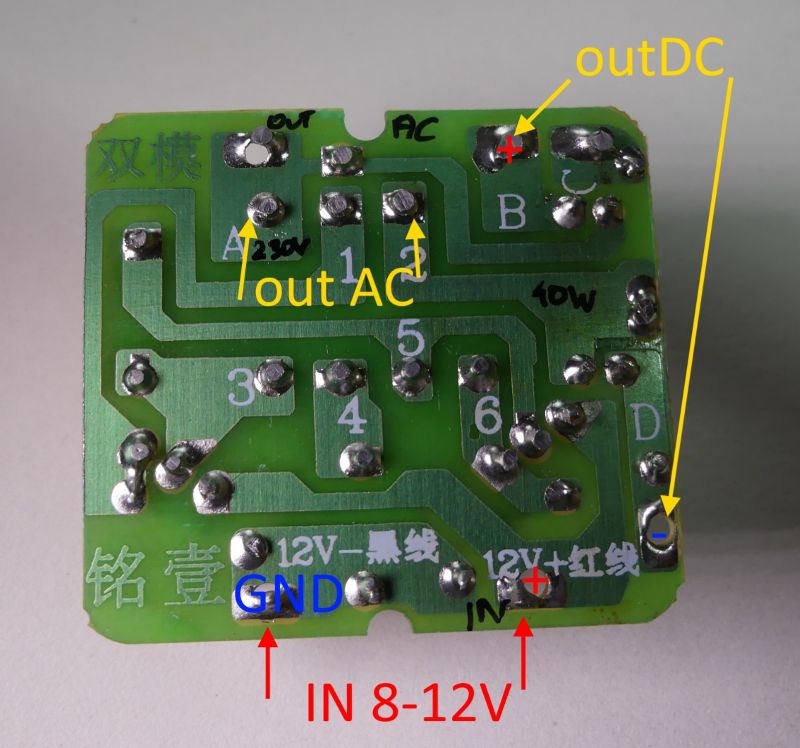
Be careful when starting up, because of the voltage threatening to health and life in the system.
When working without load, the system consumes ~ 68mA, supply voltage 12V, the rectified output voltage may reach even 400V, such configuration should be avoided.
After loading the LED GU10 8W output, 0.87A current flows at the input of the system at a voltage of 12V, while the output is ~ 260V and 30mA:
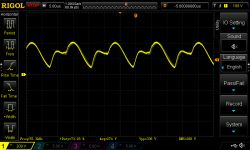
After connecting two LED GU10 8W, a current of 1.73A flows at the input at 12V, the output is 230V and 66mA:
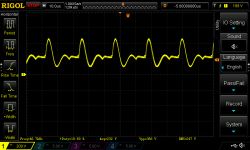
The efficiency of the system is ~ 73%, the transistors heat up quite a bit during operation, a small heat sink should allow the heat to dissipate. The connected light sources worked satisfactorily at the input voltage of 9-12V, while they went out completely at about 5V.
To sum up: a dangerous system (no output voltage control),
lack of documentation,
errors in the auction descriptions,
information suggesting that the output will be 220V AC (which suggests the mains voltage),
in fact we get an undefined high frequency AC voltage, or DC.
When connecting an unloaded simple AC-> DC converter as a receiver, there is a risk of explosion of the electrolytic capacitor (too high supply voltage).
With careful use, the module can be useful to power 230V light sources, and the board can fit in the base of the lamp holder. You can use a 12V installation or even a battery power supply (e.g. 6x1.5V AA) for power supply. If we install an effective 230V LED luminaire, which is rarely turned on for a short time (e.g. above a mirror), the module can replace (or delay) ) 230V power supply, wall hammering, cable routing, etc. works.
) 230V power supply, wall hammering, cable routing, etc. works.
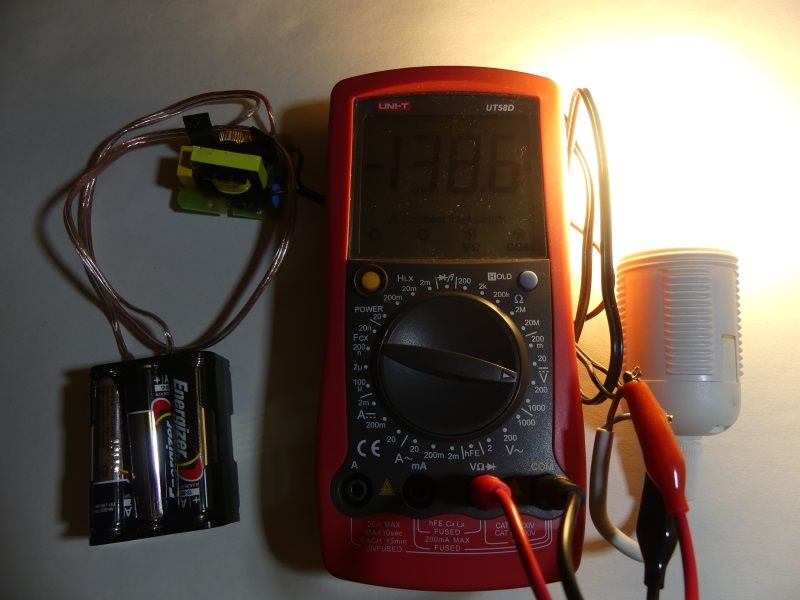
After starting the module, as expected, it turned out that a ~ 40kHz sine wave appears on the secondary side of the transformer, the effective voltage may reach several hundred volts in no-load condition. As the power consumption increases, the output voltage drops to the 220V visible in the description and even less 90-100V. On the board you will find the fields marked -12V (GND) and + 12V where we connect the 8-12V supply voltage. In points B and D we get a rectified output voltage of 100-300V.

Be careful when starting up, because of the voltage threatening to health and life in the system.
When working without load, the system consumes ~ 68mA, supply voltage 12V, the rectified output voltage may reach even 400V, such configuration should be avoided.
After loading the LED GU10 8W output, 0.87A current flows at the input of the system at a voltage of 12V, while the output is ~ 260V and 30mA:

After connecting two LED GU10 8W, a current of 1.73A flows at the input at 12V, the output is 230V and 66mA:

The efficiency of the system is ~ 73%, the transistors heat up quite a bit during operation, a small heat sink should allow the heat to dissipate. The connected light sources worked satisfactorily at the input voltage of 9-12V, while they went out completely at about 5V.
To sum up: a dangerous system (no output voltage control),
lack of documentation,
errors in the auction descriptions,
information suggesting that the output will be 220V AC (which suggests the mains voltage),
in fact we get an undefined high frequency AC voltage, or DC.
When connecting an unloaded simple AC-> DC converter as a receiver, there is a risk of explosion of the electrolytic capacitor (too high supply voltage).
With careful use, the module can be useful to power 230V light sources, and the board can fit in the base of the lamp holder. You can use a 12V installation or even a battery power supply (e.g. 6x1.5V AA) for power supply. If we install an effective 230V LED luminaire, which is rarely turned on for a short time (e.g. above a mirror), the module can replace (or delay)

Cool? Ranking DIY



